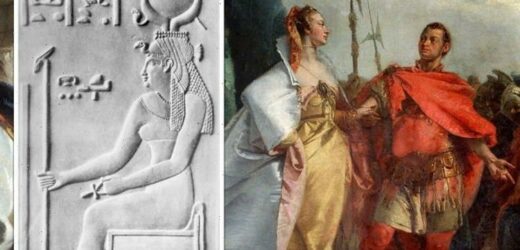Cleopatra: Expert travels down 'hidden' chamber
We use your sign-up to provide content in ways you’ve consented to and to improve our understanding of you. This may include adverts from us and 3rd parties based on our understanding. You can unsubscribe at any time. More info
Despite her fame, she has eluded scientists and archaeologists for years, with them yet to discover her final resting place. Most experts only have historical accounts to back up their knowledge, interspersed with occasional discoveries. Some have proven groundbreaking puzzle pieces building on her true identity.
The tomb at Taposiris Magna
One of the many mysteries around Cleopatra’s final resting place pertains to where she wanted to spend her death.
Experts tend to split their guesses between Alexandria – where she was born and spent most of her reign – and Taposiris Magna.
The latter city, an ancestral home of hers, was just 30 miles away.
In July 2020, archaeologists discovered burial chambers of two high-status figures in Taposiris Magna that would have lived alongside Cleopatra between 69 and 30 BC.
The chamber, discovered for the first time since it was closed 2,000 years ago, contained evidence that the figures once lay under gold leaf.
The find suggested they may have interacted with Cleopatra, meaning she may rest nearby.


Ancient coinage
Cleopatra has existed in varying art forms over the years, with famous depictions in sculpture, paintings, film and more.
Artists have held her as a feminine beauty, but this may be quite far from the truth.
Ancient coinage discovered by archaeologists has revealed she may have had a more masculine profile.
A 2,000-year-old coin discovered in 2007 shows a much different Cleopatra, with a protruding jawline and thick neck.
Experts studied the coin after finding it within a collection from the Newcastle-based Society of Antiquaries.
The coin’s reverse held an image of the queen’s famous lover Mark Antony.


Ancient accounts
Historical accounts maintained Cleopatra died by suicide alongside Mark Antony in 30 BC.
The queen settled on death by asp and allegedly persuaded the venomous snake to bite and kill her.
But the discovery of ancient accounts from Plutarch cast doubt on whether this happened.
He concluded that the events surrounding hers and Mark Antony’s deaths were “known to no one”.
Other accounts have doubted the asp legend, noting Cleopatra’s fascination with deadly poisons.
Another historian, Strabo, theorised that she may have induced death with an “ointment”.

A papyrus document
One of the most important finds relating to Cleopatra was a simple papyrus sheet.
An early find during the early days of Egyptology, the sheet discovered between 1903 and 1905 is said to bear her handwriting.
The paper contains a text recording tax breaks for one of her lover Mark’s generals.
And it contains a Greek sign off, with the word ginesthoi scrawled below.
The word means “make it so”, and archaeologists believe Cleopatra’s was the hand behind it.
Abusir
Abusir is a town on Egypt’s Nile Delta, and its significance is already well established in Egyptian history.
The site holds several tombs and the remains of a temple located between a nearby lake and the sea.
In 2009, Egyptian archaeologists descended on the town, believing Cleopatra had chosen to rest there with Mark Antony.
They found a bust bearing the Roman’s hallmark cleft chin and coinage bearing the queen’s face.
Coordinated with the accounts provided by Plutarch, the finds suggest another potential burial place.
But professors are yet to find any scientific evidence pointing towards this.
Source: Read Full Article


